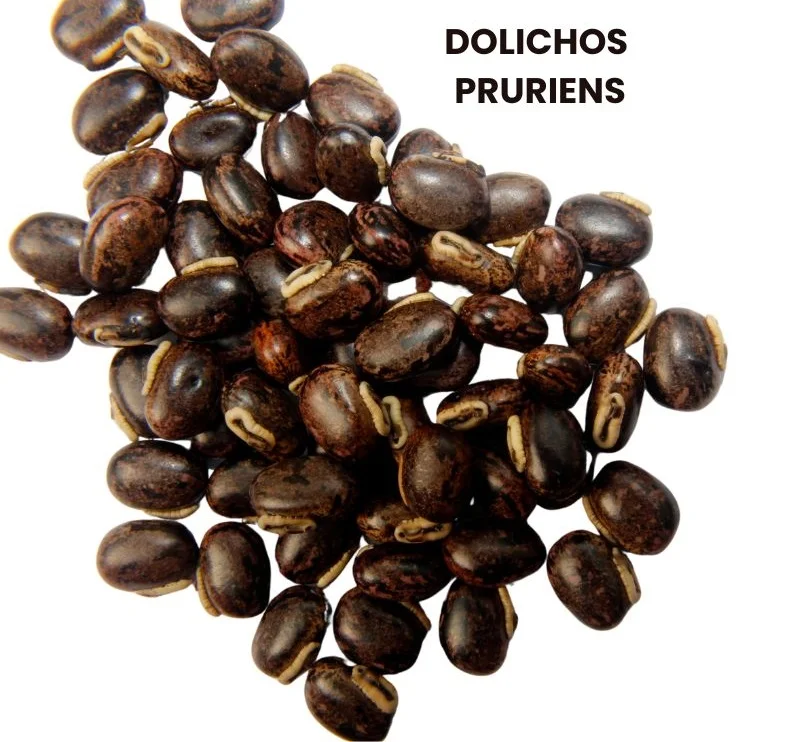Dolichos pruriens, also known as Mucuna pruriens, is a tropical legume belonging to the Fabaceae family, originally native to Africa and Asia.
This plant has a long-standing history in traditional medicinal practices, particularly in Ayurveda, where its seeds are prized for their therapeutic properties.
Known for its efficacy in treating conditions like intense itching, liver disorders, and hemorrhoids, Dolichos pruriens has gained global recognition and is now cultivated widely across tropical regions.

SOURCE INFORMATION
- Scientific Name: Dolichos pruriens (also known as Mucuna pruriens)
- Family: Fabaceae (Leguminosae)
Origin and Distribution
- Dolichos pruriens, commonly known as Cowhage or Velvet Bean, belongs to the Fabaceae family and is native to tropical regions of Africa and Asia.
- Due to its medicinal properties and agricultural uses, it has been introduced and cultivated in various tropical areas worldwide.
- The plant is valued for its seeds, which are rich in L-DOPA (levodopa), a precursor to dopamine, making it significant in traditional medicine and pharmacology.
Historical Facts
- This plant has a long history of use in traditional medicinal systems such as Ayurveda, where it has been employed for its various therapeutic benefits.
- It has traditionally been used for treating conditions ranging from neurological disorders to skin ailments and digestive issues.
Homeopathic Application
- In homeopathy, Dolichos pruriens is primarily indicated for its distinctive symptoms related to itching, liver disorders, and hemorrhoids.
- It is considered a right-sided medicine, indicating that symptoms predominantly manifest on the right side of the body.
- It is prescribed in potentized forms to address specific symptom pictures in patients, aligning with the principles of homeopathic treatment.
DRUG PATHOGENESIS
- Dolichos pruriens is associated with intense itching without any visible skin eruptions, which is a peculiar symptom of the remedy.
- This itching can be generalized or specific to certain areas such as the shoulders, elbows, knees, and hairy parts of the body.
- It also affects the liver, leading to conditions like jaundice and swelling of the liver.
DETAILED ORGAN SYMPTOMS
THROAT
- Pain in the Throat: Dolichos pruriens is indicated for pain in the throat, particularly below the right angle of the jaw.
- The pain is described as feeling like a splinter vertically embedded, which worsens when swallowing.
- Gum Pain: Pain in the gums may also be present, causing discomfort that interferes with sleep.
ABDOMEN
- Colic from Getting Feet Wet: Exposure to wet conditions can trigger colic in individuals needing Dolichos pruriens.
- Constipation with Intense Itching: Constipation accompanied by severe itching is a characteristic symptom.
- The abdomen may feel bloated, and stools can be white in colour.
- Liver Swelling: There may be swelling of the liver, indicating liver involvement.
- Hemorrhoids with Burning Sensation: Dolichos pruriens is indicated for hemorrhoids that cause a burning sensation, adding to the abdominal discomfort.
SKIN
- Intense Itching: One of the primary symptoms of Dolichos pruriens is intense itching across various parts of the body, especially at night and in hairy areas.
- This itching occurs without any visible rash.
- Jaundice and Yellow Spots: Itching may be accompanied by jaundice, where the skin and whites of the eyes turn yellow.
- Yellow spots on the skin may also be observed.
- Herpes Zoster (Shingles): Dolichos pruriens is noted for its effectiveness in treating herpes zoster, commonly known as shingles, which manifests as a painful skin rash.
MODALITIES
Worse
- Symptoms worsen at night.
- Aggravation from scratching.
- Affected predominantly on the right side of the body.
WHAT ARE MODALITIES IN HOMOEOPATHY?
RELATIONSHIP WITH OTHER DRUGS
Compare with
- Rhus tox: Similarities in itching symptoms, especially worse at night, and modalities of aggravation from scratching.
- Belladonna: Both remedies address throat pain and inflammatory conditions.
- Hepar sulph: Both have indications for painful conditions and inflammatory states.
- Nitric acid: Both remedies share symptoms related to skin disorders and pain aggravation.
- Fagopyrum: Similarities in symptoms related to itching and skin eruptions.
DOSE
- Typically prescribed in the sixth potency.
- Tincture may be used in drop doses for haemorrhoids.
Frequently Asked Questions
What is Dolichos pruriens used for in homeopathy?
- Dolichos pruriens is primarily used for intense itching without a visible rash, liver disorders including jaundice, and haemorrhoids with burning sensations.
What are the main symptoms of Dolichos pruriens?
- The main symptoms include intense itching, especially at night and without eruptions, liver symptoms like jaundice and liver swelling, and specific modalities such as aggravation from scratching and symptoms predominantly on the right side.
What is a haemorrhoidal diathesis?
- Haemorrhoidal diathesis refers to a predisposition or constitutional tendency towards developing hemorrhoids, which are swollen and inflamed veins in the anus or lower rectum.
Meaning of Difficult Words
- Diathesis: A constitutional predisposition or tendency.
- Jaundice: Yellowing of the skin and whites of the eyes due to high bilirubin levels in the blood.
- Haemorrhoids: Swollen and inflamed veins in the anus or lower rectum causing discomfort or bleeding.
- L-DOPA: Levodopa, a precursor to dopamine used in the treatment of Parkinson’s disease.
This comprehensive understanding of Dolichos pruriens helps in its application in homeopathy, particularly in addressing specific symptoms related to itching, liver disorders, and haemorrhoids, aligning with its traditional use and clinical indications.
